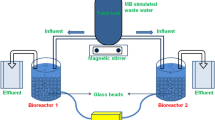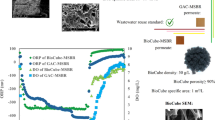Abstract
Combinations of sequential anaerobic and aerobic process enhance the treatment of textile wastewater. The aim of this study was to investigate the treatment of diazo dye Reactive Black 5 (RB5)-containing wastewater using granular activated carbon (GAC)–biofilm sequencing batch reactor (SBR) as an integration of aerobic and anaerobic process in a single reactor. The GAC–biofilm SBR system demonstrated higher removal of COD, RB5 and aromatic amines. It was observed that the RB5 removal efficiency improved as the concentration of co-substrate in the influent increased. The alternative aeration introduced into the bioreactor enhanced mineralization of aromatic amines. Degradation of RB5 and co-substrate followed second-order kinetic and the constant (k 2) values for COD and RB5 decreased from 0.002 to 0.001 and 0.004 to 0.001 l/mg h, respectively, as the RB5 concentration increased from 100 to 200 mg/l in the GAC–biofilm SBR system.





Similar content being viewed by others
References
Barragán, B. E., Costa, C., & Márquez, M. C. (2007). Biodegradation of azo dyes by bacteria inoculated on solid media. Dyes and Pigments, 75(1), 73–81.
Bra's, R., Ferra, M. I. A., Pinheiro, H. M., & Goncalves, I. C. (2001). Batch test for assessing decolourization of azo dyes by methanogenic and mixed cultures. Journal of Biotechnology, 89, 155–252.
Christopher, J., Owen, P. W., & Ajay, S. (2002). Biodegradation of dimethyl phthalate with high removal rates in a packed-bed reactor. World Journal of Microbiology and Biotechnology, 18, 7–10.
Clarke, E.A., & Anliker, R. (1980). Organic dyes and pigments. Hand-book of environmental chemistry, anthropogenic compounds. New York.
Eltaief, K., Hana, G., Youssef, T., Hassib, B., & Moktar, H. (2008). Aerobic decolourization of the indigo dye-containing textile wastewater using continuous combined bioreactors. Journal of Hazardous Materials, 52(2), 683–689.
Haug, W., Schmidt, A., Nörtemam, B., Hempel, D. C., Stolz, A., & Knackmuss, H. J. (1991). Mineralisation of the sulphonated azo dye Mordant Yellow 3 by a 6-aminonaphthalene-2-benzenesulfonate-degrading bacterial consortium. Applied and Environmental Microbiology, 57, 3144–3149.
Işık, M., & Sponza, D. T. (2005). A batch study for assessing the inhibition effect of Direct Yellow 12 in a mixed methanogenic culture. Process Biochemistry, 40, 1053–1062.
Kapdan, I. K., & Alparslan, S. (2005). Application of anaerobic–aerobic sequential treatment system to real textile wastewater for color and COD removal. Enzyme and Microbial Technology, 36(2–3), 273–279.
Kapdan, I. K., & Kargi, F. (2002). Biological decolorization of textile dyestuff containing wastewater by Coriolus versicolor in a rotating biological contractor. Enzyme and Microbial Technology, 30, 195–199.
Kudlich, M., Bishop, P. L., Knackmuss, H. J., & Stolz, A. (1996). Simultaneous anaerobic and aerobic degradation of the sulfonated azo dye Mordant Yellow 3 by immobilized cells from a naphthalenesulfonate-degrading mixed culture. Applied and Environmental Microbiology, 46, 597–603.
Lu, X., Yang, B., Chen, J., & Sun, R. (2009). Treatment of wastewater containing azo dye reactive brilliant red X-3B using sequential ozonation and upflow biological aerated filter process. Journal of Hazardous Materials, 161, 241–245.
Manu, B., & Chaudhari, S. (2002). Anaerobic decolorization of simulated textile wastewater containing azo dyes. Bioresource Technology, 82, 225–231.
Nigam, P., Banat, I.M., Singh, D., Marchant, R. (1996). Microbial process for the decolorization of textile effluent containing azo, diazo and reactive dyes. Process Biochemistry, 31(5), 435–442.
Ong, S. A., Toorisaka, E., Hirata, M., & Hano, T. (2005a). Treatment of azo dye Orange II in a sequential anaerobic and aerobic-sequencing batch reactor system. Environmental Chemistry Letters, 2(4), 203–207.
Ong, S. A., Toorisaka, E., Hirata, M., & Hano, T. (2005b). Decolorization of azo dye (Orange II) in a sequential UASB-SBR system. Separation and Purification Technology, 42(3), 297–302.
Ong, S. A., Toorisaka, E., Hirata, M., & Hano, T. (2008). Granular activated carbon–biofilm configured sequencing batch reactor treatment of C.I. Acid Orange 7. Dyes and Pigments, 76(1), 142–146.
Osman, G., Aysenur, K., & Sadik, D. (2006). The reuse of dried activated sludge for adsorption of reactive dye. Journal of Hazardous Materials, 134(1–3), 190–196.
Rajaguru, R., Kalaiselvi, K., Palamivel, M., & Subburam, V. (2000). Biodegradation of azo dyes in a sequential anaerobic–aerobic system. Applied Microbiology and Biotechnology, 54, 268–273.
Sandhaya, S., Padmavathy, S., Swaminathan, K., Subrahmanyam, Y. V., & Kaul, S. N. (2005). Microaerophilic–aerobic sequential batch reactor for treatment of azo dyes containing simulated wastewater. Process Biochemistry, 40, 885–890.
Sarioglu, M., & Bisgin, T. (2007). Removal of Maxilon Yellow GL in a mixed methanogenic anaerobic culture. Dyes and Pigments, 75(3), 544–549.
Schreiber, M. E., & Bahr, J. M. (2002). Nitrate-enhanced bioremediation of BTEX-contaimnated ground water: parameter estimation from natural gradient tracer experiments. Journal of Contaminant Hydrology, 55, 2–56.
Sponza, D. T., & Isik, M. (2002). Decolorization and azo dye degradation by anaerobic/aerobic sequential process. Enzyme and Microbial Technology, 31, 102–110.
Sponza, D. T., & Isik, M. (2004). Decolorization and inhibition kinetic of Direct Black 38 azo dye with granulated anaerobic sludge. Enzyme and Microbial Technology, 34(2), 147–158.
Tong, Y., & Bishop, P. L. (1998). Stratification of microbial metabolic processes and redox potential change in an aerobic biofilm studied using microelectrodes. Water Science and Technology, 37(4–5), 195–198.
Van der Zee, F. P. (2002). Anaerobic azo dye reduction. Doctoral thesis, Wageningen (p. 142). The Netherlands: Wageningen University.
Van der Zee, F. P., & Villaverde, S. (2005). Combined anaerobic–aerobic treatment of azo dyes—A short review of bioreactor studies. Water Research, 39(8), 1425–1440.
Van der Zee, F. P., Lettinga, G., & Field, J. A. (2001). Azo dye decolorization by anaerobic granular sludge. Chemosphere, 44, 1169–1176.
Wijetunga, S., Xiufen, L., Wenquan, R., & Chen, J. (2008). Evaluation of the efficacy of upflow anaerobic sludge blanket reactor in removal of color and reduction of COD in real textile wastewater. Bioresource Technology, 99, 3692–3699.
Yang, P. Y., Nitisoravut, S., & Wu, J. Y. S. (1995). Nitrate removal using a mixed culture entrapped microbial cell immobilization process under high salt conditions. Water Research, 29(6), 1525–1532.
Yang, Q., Li, C., Li, H., Li, Y., & Yu, N. (2009). Degradation of synthetic reactive azo dyes and treatment of textile wastewater by a fungi consortium reactor. Biochemical Engineering Journal, 43(3), 225–230.
Zhou, G. M., & Herbert, H. P. F. (1997). Anoxic treatment of low-strength wastewater by immobilized sludge. Water Science and Technology, 36(12), 135–141.
Author information
Authors and Affiliations
Corresponding author
Rights and permissions
About this article
Cite this article
Ong, SA., Ho, LN., Wong, YS. et al. Performance and Kinetic Study on Bioremediation of Diazo Dye (Reactive Black 5) in Wastewater Using Spent GAC–Biofilm Sequencing Batch Reactor. Water Air Soil Pollut 223, 1615–1623 (2012). https://doi.org/10.1007/s11270-011-0969-4
Received:
Accepted:
Published:
Issue Date:
DOI: https://doi.org/10.1007/s11270-011-0969-4




